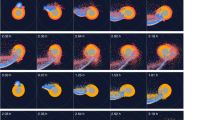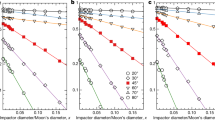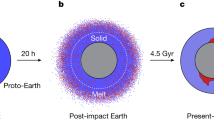Abstract
The most striking geological feature of the Moon is the terrain and elevation dichotomy1 between the hemispheres: the nearside is low and flat, dominated by volcanic maria, whereas the farside is mountainous and deeply cratered. Associated with this geological dichotomy is a compositional and thermal variation2,3, with the nearside Procellarum KREEP (potassium/rare-earth element/phosphorus) Terrane and environs interpreted as having thin, compositionally evolved crust in comparison with the massive feldspathic highlands. The lunar dichotomy may have been caused by internal effects (for example spatial variations in tidal heating4, asymmetric convective processes5 or asymmetric crystallization of the magma ocean6) or external effects (such as the event that formed the South Pole/Aitken basin1 or asymmetric cratering7). Here we consider its origin as a late carapace added by the accretion of a companion moon. Companion moons are a common outcome of simulations8 of Moon formation from a protolunar disk resulting from a giant impact, and although most coplanar configurations are unstable9, a ∼1,200-km-diameter moon located at one of the Trojan points could be dynamically stable for tens of millions of years after the giant impact10. Most of the Moon’s magma ocean would solidify on this timescale11,12, whereas the companion moon would evolve more quickly into a crust and a solid mantle derived from similar disk material, and would presumably have little or no core. Its likely fate would be to collide with the Moon at ∼2–3 km s−1, well below the speed of sound in silicates. According to our simulations, a large moon/Moon size ratio (∼0.3) and a subsonic impact velocity lead to an accretionary pile rather than a crater, contributing a hemispheric layer of extent and thickness consistent with the dimensions of the farside highlands1,13 and in agreement with the degree-two crustal thickness profile4. The collision furthermore displaces the KREEP-rich layer to the opposite hemisphere, explaining the observed concentration2,3.
This is a preview of subscription content, access via your institution
Access options
Subscribe to this journal
Receive 51 print issues and online access
$199.00 per year
only $3.90 per issue
Buy this article
- Purchase on Springer Link
- Instant access to full article PDF
Prices may be subject to local taxes which are calculated during checkout



Similar content being viewed by others
References
Zuber, M. T., Smith, D. E., Lemoine, F. G. & Neumann, G. A. The shape and internal structure of the moon from the Clementine mission. Science 266, 1839–1843 (1994)
Lawrence, D. J. Global elemental maps of the moon: the Lunar Prospector gamma-ray spectrometer. Science 281, 1484–1489 (1998)
Jolliff, B. L., Gillis, J. J., Haskin, L. A., Korotev, R. L. & Wieczorek, M. A. Major lunar crustal terranes: surface expressions and crust-mantle origins. J. Geophys. Res. 105, 4197–4216 (2000)
Garrick-Bethell, I., Nimmo, F. & Wieczorek, M. Structure and formation of the lunar farside highlands. Science 330, 949–951 (2010)
Loper, D. E. & Werner, C. L. On lunar asymmetries 1. Tilted convection and crustal asymmetry. J. Geophys. Res. Planets 107, 131–137 (2002)
Wasson, J. T. & Warren, P. H. Contribution of the mantle to the lunar asymmetry. Icarus 44, 752–771 (1980)
Wood, J. A. Bombardment as a cause of the lunar asymmetry. Moon 8, 73–103 (1973)
Ida, S., Canup, R. M. & Stewart, G. R. Lunar accretion from an impact-generated disk. Nature 389, 353–357 (1997)
Canup, R. M., Levison, H. F. & Stewart, G. R. Evolution of a terrestrial multiple-moon system. Astron. J. 117, 603–620 (1999)
Cuk, M. & Gladman, B. J. The fate of primordial lunar Trojans. Icarus 199, 237–244 (2009)
Elkins-Tanton, L. T., Burgess, S. & Yin, Q.-Z. The lunar magma ocean: reconciling the solidification process with lunar petrology and geochronology. Earth Planet. Sci. Lett. 304, 326–336 (2011)
Meyer, J., Elkins-Tanton, L. & Wisdom, J. Coupled thermal–orbital evolution of the early moon. Icarus 208, 1–10 (2010)
Wieczorek, M. The constitution and structure of the lunar interior. Rev. Mineral. Geochem. 60, 221–364 (2006)
Benz, W. & Asphaug, E. Simulations of brittle solids using smooth particle hydrodynamics. Comput. Phys. Commun. 87, 253–265 (1995)
Jutzi, M., Benz, W. & Michel, P. Numerical simulations of impacts involving porous bodies. I. Implementing sub-resolution porosity in a 3D SPH hydrocode. Icarus 198, 242–255 (2008)
Jutzi, M. & Asphaug, E. Mega-ejecta on asteroid Vesta. Geophys. Res. Lett. 38, L01102 (2011)
Jop, P., Forterre, Y. & Pouliquen, O. A constitutive law for dense granular flows. Nature 441, 727–730 (2006)
Benz, W. The origin of the moon and the single-impact hypothesis. I. Icarus 66, 515–535 (1986)
Canup, R. M. & Asphaug, E. Origin of the Moon in a giant impact near the end of the Earth’s formation. Nature 412, 708–712 (2001)
Melosh, H. J. Impact Cratering: A Geologic Process (Oxford Univ. Press, 1989)
Housen, K. R., Schmidt, R. M. & Holsapple, K. A. Crater ejecta scaling laws: fundamental forms based on dimensional analysis. J. Geophys. Res. 88, 2485–2499 (1983)
Warren, P. H. The magma ocean concept and lunar evolution. Annu. Rev. Earth Planet. Sci. 13, 201–240 (1985)
Parmentier, E. M., Zhong, S. & Zuber, M. T. Gravitational differentiation due to initial chemical stratification: origin of lunar asymmetry by the creep of dense KREEP? Earth Planet. Sci. Lett. 201, 473–480 (2002)
Zuber, M. T. et al. in Proc. 39th Lunar Planet. Sci. Conf. abstr. 1074, 〈http://www.lpi.usra.edu/meetings/lpsc2008/pdf/1074.pdf〉 (Lunar and Planetary Institute, 2008)
Acknowledgements
Our work is sponsored by NASA’s Planetary Geology and Geophysics programme ‘Small Bodies and Planetary Collisions’. All simulations were run at the University of California, Santa Cruz, on the NSF-MRI-sponsored ‘pleiades’ cluster. We are grateful to M. Cuk, B. Gladman and R. Canup for guidance.
Author information
Authors and Affiliations
Contributions
Both authors contributed equally to this work.
Corresponding author
Ethics declarations
Competing interests
The authors declare no competing financial interests.
Rights and permissions
About this article
Cite this article
Jutzi, M., Asphaug, E. Forming the lunar farside highlands by accretion of a companion moon. Nature 476, 69–72 (2011). https://doi.org/10.1038/nature10289
Received:
Accepted:
Published:
Issue Date:
DOI: https://doi.org/10.1038/nature10289
This article is cited by
-
Vestiges of a lunar ilmenite layer following mantle overturn revealed by gravity data
Nature Geoscience (2024)
-
Lunar compositional asymmetry explained by mantle overturn following the South Pole–Aitken impact
Nature Geoscience (2022)
-
Constraining the Evolutionary History of the Moon and the Inner Solar System: A Case for New Returned Lunar Samples
Space Science Reviews (2019)
-
Creating an isotopically similar Earth–Moon system with correct angular momentum from a giant impact
Journal of Astrophysics and Astronomy (2018)
-
A multiple-impact origin for the Moon
Nature Geoscience (2017)
Comments
By submitting a comment you agree to abide by our Terms and Community Guidelines. If you find something abusive or that does not comply with our terms or guidelines please flag it as inappropriate.



